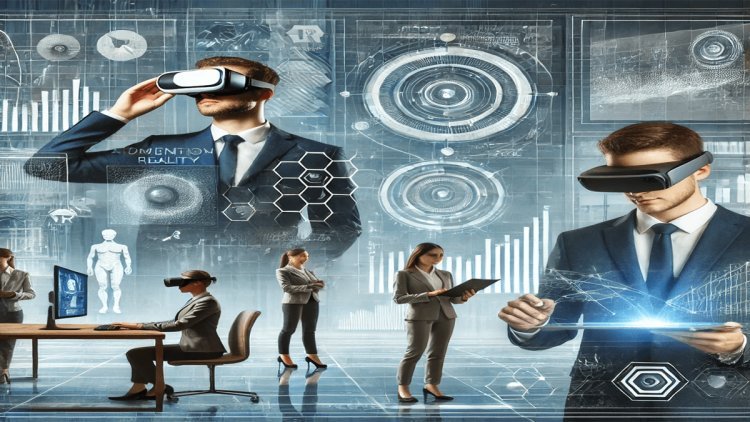Embracing Immersive Technologies in Business: Transforming the Future
Discover how immersive technologies like AR, VR, and MR are revolutionizing business operations, enhancing customer engagement, and boosting efficiency. Learn key benefits, industry applications, and future trends to stay competitive.

Immersive technologies, including Virtual Reality (VR), Augmented Reality (AR), and Mixed Reality (MR), are revolutionizing industries worldwide. By merging digital elements with the physical world, these technologies deliver unparalleled experiences, enabling businesses to innovate, improve efficiency, and engage customers more effectively.
In this article, we explore the significance of immersive technologies in business, their benefits, and how companies can leverage them to stay competitive.
What Are Immersive Technologies?
Immersive technologies are tools that blur the line between reality and digital environments. They include:
- Virtual Reality (VR): Simulates a fully digital environment through devices like VR headsets.
- Augmented Reality (AR): Overlays digital content onto the physical world, often through smartphones or AR glasses.
- Mixed Reality (MR): Combines real and virtual elements for interactive experiences in hybrid environments.
These technologies are increasingly being adopted across sectors, from retail to healthcare, reshaping how businesses operate and interact with their audiences.
Key Benefits of Immersive Technologies in Business
- Enhanced Customer Engagement
AR and VR enable businesses to create memorable experiences that captivate customers. For instance, furniture retailers like IKEA use AR to allow customers to visualize how products fit in their homes. - Cost-Efficient Training Solutions
Immersive technologies offer safe, cost-effective training environments. Industries such as aviation and healthcare use VR simulations to train staff without risking lives or resources. - Improved Collaboration and Communication
Tools like Microsoft Mesh for MR are transforming remote collaboration, enabling teams to work together in virtual spaces as if they were physically present. - Personalized Marketing and Sales
Immersive technologies enable businesses to tailor experiences to individual preferences. Brands like Sephora leverage AR for virtual makeup trials, increasing customer satisfaction and sales. - Streamlined Prototyping and Product Design
Companies use VR and MR to prototype products and environments, reducing time and costs associated with physical models. Automotive giants like Ford are pioneers in leveraging VR for design processes.
Applications of Immersive Technologies Across Industries
- Retail
AR applications are transforming the retail landscape. From virtual fitting rooms to personalized shopping experiences, brands are engaging customers in novel ways.
Example: Nike employs AR to help customers find the perfect shoe size by scanning their feet through an app.
- Healthcare
VR and AR are invaluable in surgical training, patient care, and therapy. VR simulations allow surgeons to practice complex procedures, while AR assists during operations by overlaying critical data in real time.
Example: AccuVein uses AR to improve the accuracy of vein detection for IV insertions.
- Real Estate
Immersive technologies help buyers visualize properties without visiting them. VR property tours allow clients to explore spaces in 3D, speeding up decision-making.
Example: Real estate agencies like Matterport create immersive virtual walkthroughs of homes and commercial spaces.
- Education and Training
VR and AR are making learning more interactive and effective. Educational institutions and businesses use these tools for experiential learning and employee training.
Example: Walmart utilizes VR to prepare employees for scenarios like holiday rushes, ensuring they are equipped to handle real-world challenges.
- Manufacturing
Immersive technologies streamline design and quality control processes in manufacturing. MR enables engineers to visualize and interact with designs before production.
Example: Boeing uses AR to guide technicians during aircraft assembly, reducing errors and improving efficiency.
Challenges in Adopting Immersive Technologies
While the benefits are substantial, businesses face several challenges:
- High Initial Investment: The cost of hardware and software can be a barrier for small businesses.
- Technical Expertise: Successful implementation requires skilled professionals, which can be scarce.
- Data Privacy Concerns: Immersive technologies often collect user data, raising concerns about security and compliance.
- Hardware Limitations: Current devices can be bulky, and improving portability and comfort remains a priority.
Future Trends in Immersive Technologies
- Integration with AI
AI-powered immersive tools will enhance personalization, allowing businesses to offer tailored experiences at scale. - 5G-Powered Experiences
The rollout of 5G networks will enable seamless and ultra-realistic AR and VR experiences with minimal latency. - Affordable Hardware
With advancing technology, the cost of devices like VR headsets is expected to decrease, making immersive technologies accessible to smaller enterprises. - Spatial Computing
Combining AR, VR, and IoT, spatial computing will enable businesses to create dynamic, interactive environments.
How Businesses Can Start Leveraging Immersive Technologies
- Identify Business Needs
Start by pinpointing areas where immersive technologies can address pain points or unlock new opportunities. - Begin with Scalable Solutions
Experiment with pilot projects like AR marketing campaigns or VR-based employee training to assess effectiveness. - Partner with Experts
Collaborate with tech companies specializing in AR, VR, and MR to ensure seamless integration. - Focus on ROI
Measure the impact of immersive technologies on customer engagement, sales, or operational efficiency to justify investments.
Conclusion
Immersive technologies are no longer futuristic concepts—they are transforming the business landscape today. By leveraging AR, VR, and MR, companies can improve efficiency, engage customers, and stay ahead of competitors. While challenges exist, strategic implementation and innovation will unlock the full potential of these tools.
Businesses that embrace immersive technologies early will not only redefine their operations but also shape the future of their industries. Now is the time to adopt these transformative tools and lead the way into a more connected, interactive, and immersive world.
What's Your Reaction?

















